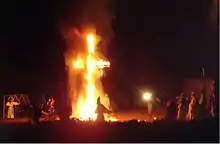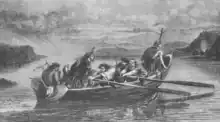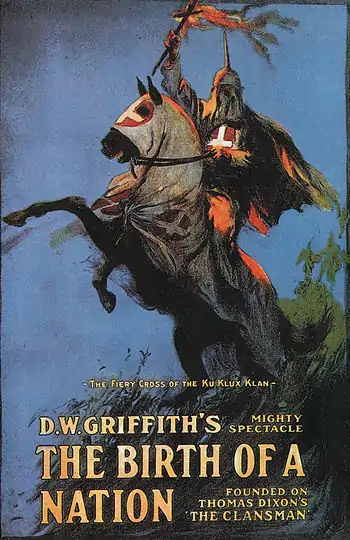Cross burning
In modern times, cross burning or cross lighting is a practice which is associated with the Ku Klux Klan. However, it was practiced long before the Klan's inception. Since the early 20th century, the Klan burned crosses on hillsides as a way to intimidate and threaten black Americans and other marginalized groups.[1][2]

Scottish origins

In Scotland, the fiery cross, known as the crann tara, was used as a declaration of war.[3] The sight of it commanded all clan members to rally to the defence of the area. On other occasions, a small burning cross would be carried from town to town. It was used in the War of 1812 between Britain and the U.S. as a means of mobilizing the Scottish Fencibles and militia which were settled in Glengarry County, Ontario against the invaders.[4] In 1820, over 800 fighting men of Clan Grant were gathered, by the passing of the fiery cross, to come to the aid of their Clan Chieftain and his sister in the town of Elgin, Scotland.[5] In Scotland itself, the last significant use of the burning cross was made in 1745, during the Jacobite rising,[6] and it was subsequently described in the novels and poetry of Sir Walter Scott, particularly The Lady of the Lake of 1810.
Symbol of the Ku Klux Klan

In the first era, reconstruction Klans did not burn crosses. The belief that reconstruction Klans burned crosses was introduced by Thomas Dixon Jr., in his novel The Clansman: A Historical Romance of the Ku Klux Klan (1905). A cross burning is first described in Book IV Chapter 2 "The Fiery Cross" on pages 324–326 of the 1905 edition. It is introduced by one of the characters as "the old Scottish rite of the burning cross. It will send a thrill of inspiration to every clansmen in the hills." It is further elaborated that
In olden times when the Chieftain of our people summoned the clan on an errand of life and death, the Fiery Cross, extinguished in sacrificial blood, was sent by swift courier from village to village. This call was never made in vain, nor will it be to-night in the new world. Here, on this spot made holy ground by the blood of those we hold dearer than life, I raise the ancient symbol of an unconquered race of men—
This scene is accompanied by an unnumbered plate illustration by Arthur I. Keller, captioned "'The fiery cross of old Scotland's hills'", showing two robed, unmasked Klansmen, one of whom is holding a lighted cross, over a bound, blindfolded and gagged black American, while robed and hooded klansmen look on.[7] The novel ends with a Klansman waiting for election results stating "Look at our lights on the mountains! They are ablaze - range on range our signals gleam until the Fiery Cross is lost among the stars" meaning that he had won and civilization had been saved in the South.[8] The fiery cross is mentioned once again in the final novel of Dixon's Klan trilogy, The Traitor: A Story of the Fall of the Invisible Empire, when a Grand Dragon tosses a burning cross on a heap of discarded Klan robes and regalia in obedience to the order of the Grand Dragon to dissolve the order.[9] This scene is accompanied by an illustration captioned "Some of the men were sobbing" by Charles David Williams featuring a gathering of Klansmen over a burning pile of robes, carrying three burning crosses.[10]
The Birth of a Nation

In D.W. Griffith's film The Birth of a Nation (1915), an adaptation of Thomas Dixon's novel, The Clansman, two sequences depict cross-burnings.
The first sequence depicts a Confederate colonel's little sister, who rejects a marriage proposal by a black captain (of the occupying Union force) and then he must flee after he chases her (the Piedmont, South Carolina legislature had legalized interracial marriages, and the story imagines the social chaos that whites feared would develop). She is cornered at the edge of a cliff and threatens to jump off the cliff unless he stops. He continues his pursuit, and she jumps.
Her brother finds her dying at the bottom of the cliff and holds her in his arms; she identifies her attacker before she passes away. The few members of the local clan burn a small (around 8 inches [20 cm]) cross, drenched in the young girl's blood. A kangaroo court is convened, hears the girl's dying words when the colonel gives his testimony, finds the captain guilty of murder, and executes him. The clan members place his body on the front porch of the South Carolina governor's mansion with a square piece of white sheeting with the initials KKK.
The second sequence depicts the aftermath of two home invasions. The first home invasion occurs at the governor's mansion. A black member of the South Carolina legislature proposes marriage to the governor's daughter and, when she rejects his proposal, he threatens her with weapons. The governor attempts to intervene but his attempt fails and he is taken captive. The second home invasion occurs at the house of the Confederate colonel; his mother was revealed to be a clan sympathizer and she expressed her sympathy for the clan by making clan uniforms. The clan wishes to intervene in these hostage situations but it is prevented from doing so by the occupying Union troops. The colonel requests help by burning a cross in the daytime; the black smoke which is produced by the burning cross signals clans from neighboring counties to come to their aid and contest the Union military's control of the town. Each clan wears distinct head-dresses and robes. They greet each other with their faces uncovered although they ride into town with sheeting over their faces. The colonel's uniform has two adjacent square crosses on his robe, presumably from the original clan in Scotland.
In the United States, the first recorded cross burning occurred on November 25, 1915, ten months after the debut of The Birth of a Nation, when a group of men which led by William J. Simmons burned a cross atop Stone Mountain, Georgia, inaugurating the revival of the Ku Klux Klan. The event was attended by 15 charter members and a few aging former members of the original Klan.[11]
Crosses were burned during the Tallahassee bus boycott of 1956.[12]
According to journalist and civil rights advocate Carey McWilliams, in California during the '30s, several crosses were burned as part of the intimidation practices of the vigilante groups which were organized to break off pickers' strikes by the Associated Farmers.[13]
In France
Croix-de-Feu (French: [kʁwa də fø], Cross of Fire) was a nationalist French league of the Interwar period.
Legal position in the United States
In 2003, the Supreme Court of the United States invoked a stage adaptation of Sir Walter Scott's The Lady of the Lake in its Virginia v. Black decision as an example of a display of cross burning that was not intended "to intimidate a person or group of persons" when they struck down a Virginia statute that included the language "Any such burning of a cross shall be prima facie evidence of an intent to intimidate a person or group of persons" because it presumes that the "intent [is] to intimidate."[14]
See also
References
- "Virginia v Black".
- "Decades After Clashing with the Klan, A Thriving Vietnamese Community in Texas". NPR.org.
- Letters from Rupert's Land, 1826–1840: James Hargrave of the Hudson's Bay
- Sketches Illustrating the Early Settlement and History of Glengarry in Canada.
- "A Wee Bit of Clan Grant History". Archived from the original on 2008-01-13. Retrieved 2008-02-27.
- The Capital Scot.
- Dixon, Thomas, 1864–1946. Arthur I. Keller, illustr. The clansman; an historical romance of the Ku Klux Klan New York Doubleday, pages 324-327
- Dixon, p. 374
- Dixon, Thomas, 1864–1946 The traitor; a story of the fall of the invisible empire New York, Doubleday, Page & Company, 1907 p.53
- Dixon, 1907 unnumbered plate between pp.52-3
- "The Various Shady Lives of the Ku Klux Klan". Time magazine. April 9, 1965. Archived from the original on August 19, 2008.
An itinerant Methodist preacher named William Joseph Simmons started up the Klan again in Atlanta in 1915. Simmons, an ascetic-looking man, was a fetishist on fraternal organizations. He was already a "colonel" in the Woodmen of the World, but he decided to build an organization all his own. He was an effective speaker, with an affinity for alliteration; he had preached on "Women, Weddings and Wives," "Red Heads, Dead Heads and No Heads," and the "Kinship of Kourtship and Kissing." On Thanksgiving Eve 1915, Simmons took 15 friends to the top of Stone Mountain, near Atlanta, built an altar on which he placed an American flag, a Bible and an unsheathed sword, set fire to a crude wooden cross, muttered a few incantations about a "practical fraternity among men," and declared himself Imperial Wizard of the Invisible Empire of the Knights of the Ku Klux Klan.
- "Tallahassee Bus Boycott Timeline", Tallahassee Democrat, May 21, 2006, "Tallahassee Democrat - Tallahassee Bus Boycott Anniversary". Archived from the original on 2015-01-28. Retrieved 2015-06-05., retrieved 6/4/2025.
- McWilliams, Carey (Author), Sackman Douglas C. (Foreword), Factories in the Field, The Story of Migratory Farm Labor in California, University of California Press, April 2000, ISBN 9780520224131, pp. 230-263
- Erwin Chemerinsky. The First Amendment, Wolters Kluwer.